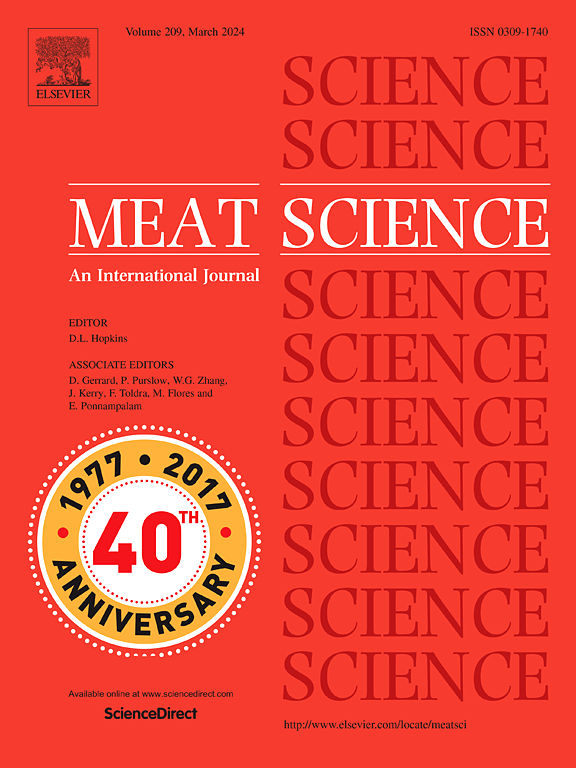The effect of sustainable vacuum packaging selection on the quality, colour stability, and freshness of lamb meat stored chilled for up to 20 weeks
IF 7.1
1区 农林科学
Q1 Agricultural and Biological Sciences
引用次数: 0
Abstract
Storage period and packaging type effects on lamb meat were investigated using 384 longissimus lumborum muscles (LL), randomly allocated to 8 storage periods (Week 0, 1, 2, 6, 10, 14, 18, and 20; −1.2 ± 1.1 °C) and 4 packaging types (PACK 1, Eco-tite® Recycle Ready Shrink Bag; PACK 2, Cryovac® Barrier Shrink Bag; PACK 3, a foil pouch; and PACK 4, Biovac™ Recyclable Vacuum Pouch). Analysis demonstrated few storage period effects on lamb meat quality. Shear force was perceivably reduced after Week 1 (P < 0.001); myofibrillar protein solubility increased with storage period (P = 0.004); and purge (P < 0.001), cooking (P < 0.05), and drip loss (P < 0.05) show a reduction in water-holding capacity between Weeks 0–14. Intramuscular fat, crude protein, dry matter, total moisture, and sarcoplasmic protein solubility were not affected by storage period (P > 0.05). The packaging effects on meat quality were somewhat limited to PACK 3. Differences in water holding capacity was most apparent between PACK 1–2 and PACK 3–4, the latter having the highest amount of water loss (P < 0.05). TVC increased with storage period (P < 0.001), but remained > log 7 CFU/g for any treatment combination. TVB-N concentrations increased between Weeks 1–14 (P < 0.001), but remained > 15 mg/100 g. Lamb meat stored for > 6 weeks became unacceptably discoloured (based on a* and brownness indices) increasingly sooner into the 3 d retail display period. These findings support a longer shelf-life for chilled lamb meat.
可持续真空包装的选择对质量,颜色稳定性和新鲜度的羊肉冷冻储存长达20周的影响
采用384块腰最长肌(LL),随机分为8个贮藏期(第0、1、2、6、10、14、18和20周;−1.2±1.1°C)和4种包装类型(PACK 1, Eco-tite®可回收收缩袋;pack2, Cryovac®屏障收缩袋;包装3,一个铝箔袋;和pack4, Biovac™可回收真空袋)。分析表明,贮藏期对羊肉品质影响不大。第1周后剪切力明显减小(P <;0.001);肌原纤维蛋白溶解度随贮藏时间的延长而增加(P = 0.004);和净化(P <;0.001),烹饪(P <;0.05),滴漏损失(P <;0.05)表明在0-14周之间持水能力下降。肌内脂肪、粗蛋白质、干物质、总水分和肌浆蛋白溶解度不受贮藏期的影响(P >;0.05)。包装对肉质的影响在一定程度上仅限于pack3。包1-2和包3-4的持水量差异最明显,包3-4失水量最大(P <;0.05)。TVC随储存期的增加而增加(P <;0.001),但仍为>;log 7 CFU/g。TVB-N浓度在第1-14周间升高(P <;0.001),但仍为>;15毫克/100克。羊肉储藏>;6周变得不可接受的变色(基于a*和棕色指数)越来越快进入3d零售展示期。这些发现支持冷藏羊肉的保质期更长。
本文章由计算机程序翻译,如有差异,请以英文原文为准。
求助全文
约1分钟内获得全文
求助全文
来源期刊

Meat Science
工程技术-食品科技
CiteScore
12.60
自引率
9.90%
发文量
282
审稿时长
60 days
期刊介绍:
The aim of Meat Science is to serve as a suitable platform for the dissemination of interdisciplinary and international knowledge on all factors influencing the properties of meat. While the journal primarily focuses on the flesh of mammals, contributions related to poultry will be considered if they enhance the overall understanding of the relationship between muscle nature and meat quality post mortem. Additionally, papers on large birds (e.g., emus, ostriches) as well as wild-captured mammals and crocodiles will be welcomed.
 求助内容:
求助内容: 应助结果提醒方式:
应助结果提醒方式:


